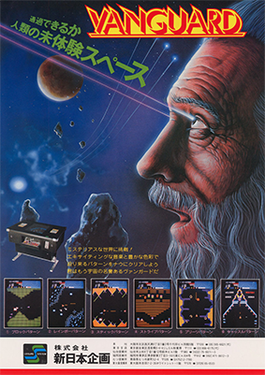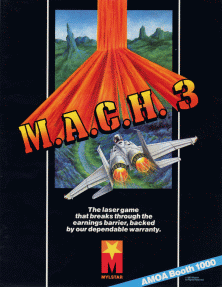
Pole Position is an arcade racing simulation video game released by Namco in 1982 and licensed to Atari, Inc. for US manufacture and distribution, running on the Namco Pole Position arcade system board. It is considered one of the most important titles from the golden age of arcade video games. Pole Position was an evolution of Namco's earlier arcade racing electro-mechanical games, notably F-1 (1976), whose designer Sho Osugi worked on the development of Pole Position.

Final Lap is a 1987 racing simulation video game developed and published by Namco. Atari Games published the game in the United States in 1988. It was the first game to run on Namco's then-new System 2 hardware and is a direct successor to Namco's Pole Position (1982) and Pole Position II (1983). It was ported to the Famicom by Arc System Works, making it Arc System Works' debut game.

The Nintendo VS. System is an arcade system developed and produced by Nintendo from 1984 to 1990. It is based on most of the same hardware as the Family Computer (Famicom), later released as the Nintendo Entertainment System (NES). As Nintendo was planning to release the NES in North America, they were aware of the video game crash of 1983 and its effects on the home console market. However by March 1984 the arcade industry recovered enough for a plan to introduce NES titles there, with the VS. System later being a presentation to players who did not yet own the console. It became the first version of the Famicom hardware to debut in North America.

Super Sprint is a racing video game released by Atari Games and Midway Games in 1986. Up to three players drive Formula One-like cars on a circuit that is viewed from above. The game is a successor to Gran Trak 10 and the Sprint series, which were black-and-white games from the 1970s. A sequel, Championship Sprint, was released later in the same year.

Star Wars is a first-person rail shooter designed by Mike Hally and released as an arcade video game in 1983 by Atari, Inc. It uses 3D color vector graphics to simulate the assault on the Death Star from the 1977 film Star Wars. There are three connected gameplay sequences: combat against TIE fighters in space, flying across the surface of the Death Star, and the final trench run. The sequence repeats with added complications and the Death Star regenerating for each. The player's X-Wing fighter has a shield which only protects against damage a certain number of times, then the next hit ends the game. Speech synthesis emulates actors from the film.

TX-1 is an arcade racing simulation game developed by Tatsumi and released in 1983. It was licensed to Namco, who in turn licensed it to Atari, Inc. for release in the United States, thus the game is considered a successor to Pole Position and Pole Position II. It was also released in the United Kingdom, Ireland and mainland Europe via Atari Ireland.

Astron Belt (アストロンベルト) is a LaserDisc video game in the form of a third-person, space combat rail shooter, released in arcades in 1983 by Sega in Japan, and licensed to Bally Midway for release in North America. Developed in 1982, it was the first major arcade laserdisc video game. The game combines full-motion video (FMV) footage from the laserdisc with real-time 2D graphics. The arcade game was available in both upright and cockpit arcade cabinets, with the latter having illuminated buttons on the control panel, a larger 25" monitor, and a force feedback vibrating seat.

Hot Rod is a top-down arcade racing game developed by Sega. Released for arcades in 1988 in Japan and released worldwide in 1989, the game was available in a four-player cocktail-style arcade cabinet, as well as a three-player upright cabinet. Home computer ports were published by Activision in 1990 for the Amiga, ZX Spectrum, Amstrad CPC, Commodore 64, and Atari ST.

Pole Position II is the sequel to racing simulation game Pole Position, released by Namco for arcades in 1983. As with its predecessor, Namco licensed this game to Atari, Inc. for US manufacture and distribution. Atari Corporation released a port as the pack-in game for its Atari 7800 ProSystem console launch in 1986. Pole Position arcade machines can be converted to Pole Position II by swapping several chips.

Vanguard is a scrolling shooter arcade video game developed by TOSE. It was released by SNK in Japan and Europe 1981, and licensed to Centuri for manufacture in North America in October and to Zaccaria in Italy the same year. Cinematronics converted the game to cocktail arcade cabinets in North America.

Final Lap 2 is an racing simulation game released by Namco for arcades in 1990. It is the arcade sequel to Final Lap and runs on Namco System 2 hardware.

Badlands (バッドランズ) is a video game released and developed by Konami on the LaserDisc system in 1984 and published by both Konami and Centuri. It debuted at the Amusement and Music Operators Association (AMOA) Show in October 1983 and was later released to the public in early 1984. In addition to its LaserDisc version, two versions of a Badlands video game cabinet exist, one produced by Konami, and one by Centuri.

Quartet (カルテット) is a run and gun video game released by Sega for arcades in 1986. Quartet allows one to four players to guide a set of characters through a base taken over by an army of robots. Players control either Joe (yellow), Mary (red), Lee (blue), or Edgar (green) across 32 side-scrolling levels. The object of the game is to advance through the level, fighting opponents that come out of portals in the walls, and eventually defeat a boss that carries the door key used to open the "exit door" for the level.

Cobra Command, known as Thunder Storm (サンダーストーム) in Japan, is an interactive movie shooter game originally released by Data East in 1984 as a LaserDisc-based arcade game. Released as an arcade conversion kit for Bega's Battle (1983), Cobra Command became one of the more successful laserdisc games in 1984. A Mega-CD port of Cobra Command developed by Wolf Team was released in 1992.

Enduro Racer (エンデューロレーサー) is an arcade racing game from Sega. It was released in 1986 with two arcade cabinet versions, a stand-up cabinet with handlebars and a full-sized dirt bike cabinet. It is often seen as a dirt racing version of Hang-On, as it uses a similar engine and PCB. The game was later released for the Master System in 1987, the ZX Spectrum and Commodore 64 in 1988, and the Amstrad CPC and Atari ST in 1989.

Star Wars: Return of the Jedi is an isometric scrolling shooter released as an arcade video game in 1984 based on the film from the previous year. It was the second arcade release by Atari based on the Star Wars franchise, but using raster graphics rather than the vector graphics of the first and third arcade games. Several home ports were released by Domark for the Amstrad CPC, BBC Micro, ZX Spectrum, Atari ST, Commodore 64, and Amiga in 1988. The game is included as an unlockable extra on Star Wars Rogue Squadron III: Rebel Strike for GameCube.

Turbo is a racing game released in arcades in 1981 by Sega. Designed and coded by Steve Hanawa, the game received positive reviews upon release, with praise for its challenging and realistic gameplay, 2.5D color graphics with changing scenery, and cockpit sit-down arcade cabinet. It topped the monthly Play Meter arcade charts in North America and ranking highly on the Game Machine arcade charts in Japan.

M.A.C.H. 3 is a shoot 'em up LaserDisc video game developed by Gottlieb and released for US arcades in 1983 under their Mylstar brand. The player controls a high-speed fighter aircraft in one of two missions: either a "Fighter Raid" seen flying forward at low altitude or "Bombing Run" seen in a top-down mode. Video backgrounds from the LaserDisc are overlaid by computer graphics. The title is both a reference to Mach number and is an acronym for "Military Air Command Hunter". It was released in Japan by Taito.

Dragon's Lair is an interactive film LaserDisc video game developed by Advanced Microcomputer Systems and published by Cinematronics in 1983, as the first game in the Dragon's Lair series. In the game, the protagonist Dirk the Daring is a knight attempting to rescue Princess Daphne from the evil dragon Singe who has locked the princess in the foul wizard Mordroc's castle. It featured animation by ex-Disney animator Don Bluth.




















